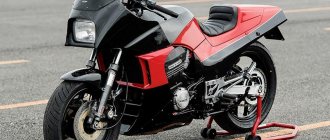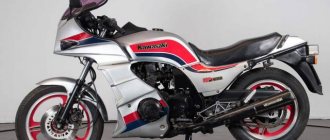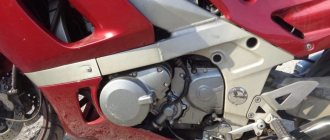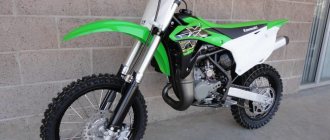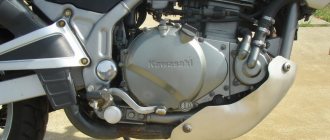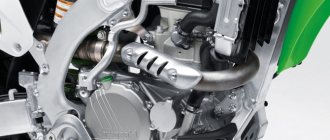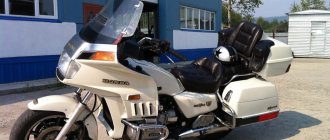Japanese motorcyclesKawasaki motorcycles
When one thinks of rare sports motorcycles, the first one that comes to mind is the Japanese model GPZ 900 R (aka ZX 900 A), better known as the Kawasaki Ninja.
This representative had all the necessary attributes confirming its belonging to the class of sport bikes.
This motorcycle, at one time, became a legend due to its highest performance and speed. But first things first.
Appearance
Stylish and proportional, this bike does not have any flair in its design. It would even be superfluous given the fact that this is a typical representative of the class. Like other sports tourists, the model differs from a simple sportbike in its dimensions. This is a long car, which makes it a great choice for traveling as a widow.
The windshield is typical. The shape reflects the sporty character of the Kawasaki GPZ 900. This is manifested in the fact that the glass is angular and low. The rims are typical for the sports and sports-touring class - alloy. The original red and black color scheme perfectly reflects the aggressive nature of this model.
In general, there is an angularity in the lines of the frame. This is a feature of such bikes from the eighties and nineties. And this approach to design is probably correct, because it completely fits into the aesthetic concept of a sporty, modern, and at the same time practical motorcycle.
Comparison with predecessor
If we compare this model with the previous one, the designers have significantly improved the motorcycle.
The ZXR750 served as the prototype for the first versions of the Ninja.
Subsequent generations of the Nine differ significantly from its predecessor.
One of the main differences can be considered a weight reduction of up to 35 kg . However, not all bikers like this upgrade. After the relief, the motorcycle became faster, which means it lost stability and safety.
Comfort
The bike is more convenient on country roads than in urban conditions. It is not very agile, large, and unlike some cruiser it does not have such stability at low speeds. However, you can get used to it.
Otherwise the car is comfortable. It's not particularly noisy, and there's enough space for the passenger to feel comfortable. The bike feels good on the road and handles well. It accelerates quickly, which will be convenient for those who know how to handle such equipment.
As for people who have previously only ridden road motorcycles, or, moreover, have not driven a bike at all, they definitely should not start with such a model, as well as with any other sport tourer or sportbike. This option will not only be inconvenient for them, but also dangerous.
pros
So that everyone knows what kind of model this is!
The main advantage is its appearance. This motorcycle has stylish body kits that cover its entire mechanism.
Sleek headlights and a long nose give it aggressiveness and power. The rear of the Kawasaki also looks impressive. The high rear tail gives the motorcycle a muscular and graceful appearance. The advantages also include the build quality of the 2-wheeled monster.
"Back" from the chain side.
"Back" from the muffler side.
The motorcycle operates for a long time without breakdowns or wear of spare parts, but under normal use, without extreme riding.
and cons
The disadvantages include the suspension. It is not intended for Russian roads, so when driving around the city or over long distances, there will be slight discomfort.
Many bikers note its weight . Compared to the previous version, it has become significantly lighter, which results in worse control and reduced safety. But it is also not uncommon for problems with gear shifting to appear - the transmission may switch to neutral speed.
Dimensions and weight
The dimensions here are classic. The Kawasaki GPZ 900 is no different in this regard from most other sports tourers.
Dimensions and weight fully satisfy the needs:
- length – 2200 mm;
- width – 750 mm;
- height – 1215 mm;
- wheelbase – 1495 mm;
- curb weight – 255 kg.
Thanks to these parameters, the model confidently stays on the road. At the same time, the car is not so heavy that it interferes with speed or maneuverability.
Estimated cost
Despite its rather advanced age, and the GPZ 900 R was produced from 1983 to 2006, the Kawasaki Ninja is a cult superbike with a huge number of admirers and fans , which speaks volumes about its quality and unique characteristics.
Confirms the popularity of the motorcycle and its long-term mass production , as well as very stable demand.
Naturally, now this model does not “fit” into a modern sportbike, but rather belongs to the category of sport-tourist.
However, the motorcycle is still popular and is offered on the secondary market in Moscow at prices ranging from 3,500 to 5,000 US dollars.
With that kind of money, you can transform into the hero of the movie “Top Gun”, who “cut” on the GPZ 900 bike, in the person of the famous Tom Cruise.
On the Kawasaki Ninja 600 motorcycle, the pilot can easily climb a couple of steps to the podium.
The maximum speed of this bike is recorded at 170.6 km/h, and acceleration to “hundreds” is achieved in 5.6-6.4 seconds.
Specifications
The filling will pleasantly please those who have long wanted to buy retro equipment, but were afraid of weak technical characteristics.
| Motor type | in-line, 2 stroke, 4 cylinders |
| Power | 115 hp |
| Torque | 85.3 Nm |
| Maximum speed | 243 km/h |
| Acceleration to 100 | 3.8 s |
| Fuel consumption per hundred | 5.88 l |
| Drive unit | chain |
| Transmission | six-speed |
| Frame | steel |
| Rear suspension | pendulum, monoshock absorber, stroke 115 mm |
| Front suspension | 41 mm, telescopic fork, 140 mm travel |
| Rear brakes | 250 mm, 1 disc, two-piston caliper |
| Front brakes | 300 mm, 2 discs, six-piston calipers |
Nothing needs to be improved. The car looks good anyway. However, it is worth noting that this applies to newer versions of the model, while the older ones are more modest. These parameters are quite enough to use the bike on a flat track. It is not suitable for off-roading in any way, because it is not a motocross motorcycle.
Production
Production of the car began in 1984. At that time this bike was considered a breakthrough. It was produced for almost twenty years, and production ended in 2003. Moreover, this year’s bikes are distinguished by the inscription “Final Edition”. This is the earliest sports car that was released under this famous brand.
Until 1993, the GPZ 900 was sold as well as produced in Europe. Since 1998, it began to be produced only in Malaysia. It is worth noting that the production of the model lasted quite a long time, which is difficult to say about most cars of the late 20th - early 21st centuries.
Classmates
The Yamaha XJ 900 S Diverse is the main competitor for this Kawasaki motorcycle. Having begun production in 1995, it disappeared from the market in 2002. In terms of characteristics, it is somewhat inferior to the GPZ 900, but the cost is more affordable.
A used model will cost around 150 thousand Russian rubles, while for a Kawasaki you will have to pay at least 200 thousand. It is no longer possible to buy either one or the other bike new.
Unless someone once bought a car and did not use it, properly storing it in the garage. But this will, of course, affect how much such a Kawasaki costs.
History of changes
The bike has come a long way and has undergone some changes:
- Production began in 1984.
- In 1986 it began to be sold in European countries.
- In 1989, heated carburetors were added.
- In 1991, the bike began to be sold in Japan.
- From 1994 to 1997 production was stopped.
- In 1999, 6-piston front suspension calipers were added.
- In 2002, a catalyst was added to help the motorcycle meet new environmental standards.
- Production discontinued in 2003.
If you compare the photos of the new and old versions, there is not much difference. That is why it is better to buy a motorcycle from the last years of production, when it was already at the peak of its development.
What do the owners say?
As for service, the majority are satisfied. Those whose model often broke down understand that the problem is largely due to poor road surfaces. In any case, judging by the reviews, it is not difficult to get spare parts for this Kawasaki.
From the descriptions of their experiences by city residents, it follows that in an urban environment, a motorcycle sometimes gets very hot.
The problem can be solved by installing forced cooling. Then, when the bike gets stuck in a traffic jam, the rider just needs to press the appropriate button and the car will quickly cool down.
There are quite a few videos that show riding a model with a helmet view. Most of those who reviewed it noted the sharp acceleration and the fact that such a car is not suitable for a beginner. They also note the ergonomic fit, which is especially important at high speeds.
In conclusion, it is worth noting that the Kawasaki GPZ 900 is suitable for those who appreciate motorcycles from the eighties and prefer a sports-touring class. A smart solution for road travel. The main thing is to remember that this option is not for off-road use.
Recommendations
- ^ a b c d f
"Performance Index Winter '12/'13 Edition" (PDF),
Motorcycle Consumer News
, Bowtie Magazines, January 2013, archived from the original (PDF) on 2016-12-29 - ^ a b c
“Indicators of sports motorcycles.”
Sport Rider
. February 25, 2014. Retrieved September 18, 2021. - ^ a b
"KAWASAKI ZX-9R Ninja". Autoevolution. Retrieved August 13, 2017. - ^ a b c d
"Review of KAWASAKI ZX-9R (1994-2002)". MCN. November 23, 2006. Retrieved August 8, 2021. - ^ a b c
“Weight and dimensions of sport bikes.”
Sport Rider
. August 23, 2011. Retrieved October 30, 2021. - Trevitt, Andrew (October 2001). "Big Dogs: The Contender". Sport Rider
. Retrieved October 30, 2021. - "Used Kawasaki sport ALLROUNDER." MOTORAD. July 2012. Retrieved October 30, 2021.
- "Nail puller." MOTORAD. February 2000. Retrieved October 30, 2016.
- https://www.cycleworld.com/sport-rider/sr-archive-open-class-shootout#page-3
- "Sport Rider Magazine June 1998: Honda CBR900rr vs. Kawasaki ZX9r vs. Yamaha YZF-R1 vs. Triumph T595 Daytona." Sport Rider
. 1998. Missing or Empty | url = (help) - "Sport Rider Magazine June 1998 Front." Sport Rider
. 1998. Retrieved August 11, 2021. - Searle, Dave (1998). "Model Comparison: CBR900RR vs ZX-9R vs YZF-R1." Motorcycle Consumer News. Retrieved August 7, 2021.
- https://www.cycleworld.com/sport-rider/tech/sportbike-performance-numbers
- https://www.arb.ca.gov/msprog/evap/evaptp98.pdf
